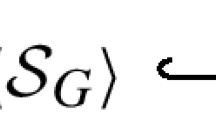Abstract
Motivated by a recent result of Robinson showing that simple endotrivial modules essentially come from quasi-simple groups we classify such modules for finite special linear and unitary groups as well as for exceptional groups of Lie type. Our main tool is a lifting result for endotrivial modules obtained in a previous paper which allows us to apply character theoretic methods. As one application we prove that the \(\ell \)-rank of quasi-simple groups possessing a faithful simple endotrivial module is at most 2. As a second application we complete the proof that principal blocks of finite simple groups cannot have Loewy length 4, thus answering a question of Koshitani, Külshammer and Sambale. Our results also imply a vanishing result for irreducible characters of special linear and unitary groups.
Similar content being viewed by others
References
Andrews, G.E.: \(q\)-analogs of the binomial coefficient congruences of Babbage, Wolstenholme and Glaisher. Discrete Math. 204, 15–25 (1999)
Benson, D.J., Carlson, J.F.: Nilpotent elements in the Green ring. J. Algebra 104, 329–350 (1986)
Bonnafé, C.: Quasi-isolated elements in reductive groups. Comm. Algebra 33, 2315–2337 (2005)
Carlson, J.: Endotrivial modules. In: Recent Developments in Lie Algebras. Groups and Representation Theory, pp. 99–111. Proceeding Symposium of Pure Math., Providence, RI (2012)
Carlson, J.F., Mazza, N., Nakano, D.: Endotrivial modules for the general linear group in nondefining characteristic. Math. Z. 278(3–4), 901–925 (2014)
Carter, R.: Finite Groups of Lie type: Conjugacy Classes and Complex Characters. Wiley, Chichester (1985)
Dudas, O., Malle, G.: Decomposition matrices for exceptional groups at \(d=4\). (Submitted). arXiv:1410.3754
Fong, P., Srinivasan, B.: Brauer trees in \(\text{ GL }(n, q)\). Math. Z. 187, 81–88 (1984)
Geck, M., Hiss, G., Lübeck, F., Malle, G., Pfeiffer, G.: \({\sf CHEVIE}\)—A system for computing and processing generic character tables for finite groups of Lie type, Weyl groups and Hecke algebras. Appl. Algebra Eng. Comm. Comput. 7, 175–210 (1996)
Geck, M., Jacon, N.: Representations of Hecke Algebras at Roots of Unity. Algebra and Applications, 15. Springer, London (2011)
James, G., Mathas, A.: A \(q\)-analogue of the Jantzen-Schaper theorem. Proc. Lond. Math. Soc. 74, 241–274 (1997)
Koshitani, S., Külshammer, B., Sambale, B.: On Loewy lengths of blocks. Math. Proc. Cambridge Philos. Soc. 156, 555–570 (2014)
Koshitani, S., Kunugi, N.: The principal 3-blocks of the 3-dimensional projective special unitary groups in non-defining characteristic. J. Reine Angew. Math. 539, 1–27 (2001)
Kunugi, N.: Morita equivalent 3-blocks of the 3-dimensional projective special linear groups. Proc. Lond. Math. Soc. 80, 575–589 (2000)
Landrock, P.: Finite Group Algebras and Their Modules. London Math. Soc. Lecture Note Series, 80. Cambridge University Press, Cambridge (1983)
Lassueur, C., Malle, G., Schulte, E.: Simple endotrivial modules for quasi-simple groups. J. Reine Angew. Math. (to appear) doi:10.1515/crelle-2013-0100
Lübeck, F., Malle, G.: A Murnaghan-Nakayama rule for values of unipotent characters in classical groups (2015, preprint)
Lusztig, G.: A unipotent support for irreducible representations. Adv. Math. 94, 139–179 (1992)
Malle, G., Testerman, D.: Linear Algebraic Groups and Finite Groups of Lie Type. Cambridge Studies in Advanced Mathematics, 133. Cambridge University Press, Cambridge (2011)
Manolov, P.: Brauer trees in finite special linear groups. C. R. Acad. Bulgare Sci. 63, 327–330 (2010)
Simpson, W.A., Frame, J.S.: The character tables for \(\text{ SL }(3, q)\), \(\text{ SU }(3, q^2)\), \(\text{ PSL }(3, q)\), \(\text{ PSU }(3, q^2)\). Can. J. Math. 25, 486–494 (1973)
The GAP Group, GAP – Groups, Algorithms, and Programming, Version 4.4 (2004), http://www.gap-system.org
Thévenaz, J.: Endo-permutation modules, a guided tour. In: Group Representation Theory, pp. 115–147. EPFL Press, Lausanne (2007)
Acknowledgments
We thank Frank Lübeck for information on the Brauer trees of \(6.{}^2\!E_6(2)\) for the prime 13, and Shigeo Koshitani for drawing our attention to [12].
Author information
Authors and Affiliations
Corresponding author
Additional information
The authors gratefully acknowledge financial support by ERC Advanced Grant 291512. The first author also acknowledges financial support by SNF Fellowship for Prospective Researchers PBELP2_143516.
Rights and permissions
About this article
Cite this article
Lassueur, C., Malle, G. Simple endotrivial modules for linear, unitary and exceptional groups. Math. Z. 280, 1047–1074 (2015). https://doi.org/10.1007/s00209-015-1465-0
Received:
Accepted:
Published:
Issue Date:
DOI: https://doi.org/10.1007/s00209-015-1465-0
Keywords
- Simple endotrivial modules
- Quasi-simple groups
- Special linear and unitary groups
- Loewy length
- Zeroes of characters



